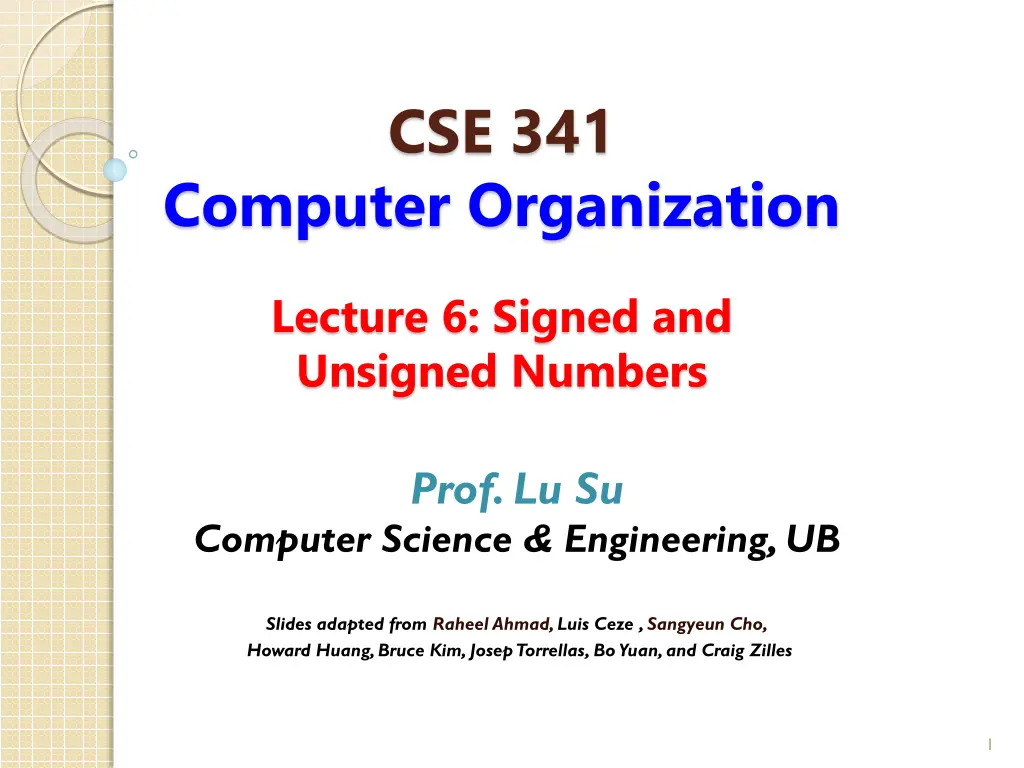
Understanding Signed and Unsigned Numbers in Computer Organization
Explore the concepts of signed and unsigned numbers in computer organization, including binary representation, two's complement, conversion methods, and more. Learn how to work with binary numbers and understand their significance in computing.
Download Presentation

Please find below an Image/Link to download the presentation.
The content on the website is provided AS IS for your information and personal use only. It may not be sold, licensed, or shared on other websites without obtaining consent from the author. If you encounter any issues during the download, it is possible that the publisher has removed the file from their server.
You are allowed to download the files provided on this website for personal or commercial use, subject to the condition that they are used lawfully. All files are the property of their respective owners.
The content on the website is provided AS IS for your information and personal use only. It may not be sold, licensed, or shared on other websites without obtaining consent from the author.
E N D
Presentation Transcript
CSE 341 Computer Organization Lecture 6: Signed and Unsigned Numbers Prof. Lu Su Computer Science & Engineering, UB Slides adapted from RaheelAhmad, Luis Ceze , Sangyeun Cho, Howard Huang, Bruce Kim, JosepTorrellas, Bo Yuan, and Craig Zilles 1
Binary Numbers In any number base, the value of ith digit d is: d Basei Numbers are kept in computer hardware as a series of high and low electronic signals, and so they are considered base 2 numbers.(binary numbers) A single digit of a binary number is called binary digits or bits. 2
Numbering of Bits within a MIPS Word Least significant bit: the rightmost bit in a MIPS word. Most significant bit: the leftmost bit in a MIPS word. Can represent 232different 32-bit patterns. 3
Unsigned Numbers Let a word represent the numbers from 0 to 232- 1(4,294,967,295ten): 32-bit binary numbers can be represented in terms of the bit value times a power of 2: These positive numbers are called unsigned numbers. 4
Signed Numbers Two s complement representation: leading 0s mean positive, and leading 1s mean negative. 5
Binary to Decimal Conversion Represent positive and negative 32-bit numbers: Example: 6
Useful shortuts A quick way to negate a two s complement binary number: Simply invert every 0 to 1 and every 1 to 0, then add one to the result. This shortcut is based on the observation that the sum of a number and its inverted representation must be 111 . . . 111two, which represents 1. x + ? = -1 ? +1 = -x o o 7
Decimal to Binary Conversion First consider the general case of binary to decimal conversion. (no sign bits but may have fraction part) For the integral part, assume there are n bits: xn-1, xn-2, , x1,x0(from left to right), we have: DI= xn-1 2n-1+ + x1 21+ x0 20 For the fractional part, assume there are n bits: x1, x2, , xn(from left to right), we have: Df= x1 2-1+ x2 2-2+ +xn 2-n 9
Decimal to Binary Conversion Convert the integral part of decimal to binary equivalent : ( ) 1. Divide the decimal number by 2 and store remainders in array. 2. Divide the quotient by 2. 3. Repeat step 2 until we get the quotient equal to zero. 4.Equivalent binary number would be reverse of all remainders of step 1. (Adapted from https://www.geeksforgeeks.org/convert-decimal-fraction-binary- number/) 10
Decimal to Binary Conversion Convert the fractional part of decimal to binary equivalent : ( ) Assume the 1. Multiply the fractional decimal number by 2. 2. Integral part of resultant decimal number will be first digit of fraction binary number. 3. Repeat step 1 using only fractional part of decimal number and then step 2. Combine both integral and fractional part of binary number. 11
Decimal to Binary Conversion Example: Convert 4.3125 to binary. (3 precision after decimal point) Step1: Conversion of 4 to binary. 1. 4/2: remainder = 0; quotient = 2; 2. 2/2: remainder = 0; quotient = 1; 3. 1/2: remainder = 1; quotient = 0; So integral part is 100. 12
Decimal to Binary Conversion Step2: Conversion of .3125 to binary. 1. 0.3125 * 2 = 0.625, integral part: 0; 2. 0.625 * 2 = 1.25, integral part: 1; 3. 0.25 * 2 = 0.5, integral part: 0; 4. 0.5 * 2 = 1, integral part: 1; So fractional part is 0.0101. Step3: 100 + 0.0101 = 100.0101. 13
Binary to Hexadecimal and Back Since base 16 is a power of 2, we can trivially convert by replacing each group of four binary digits by a single hexadecimal digit, and vice versa. 14
Binary to Hexadecimal and Back Example: 15
Notation in C Binary: C doesn t support binary literals, but we can use 0b before the binary number in C++ 14. Octal: 0 before octal number. Hexadecimal: 0x before hex number. Decimal: no other notation. 16






















